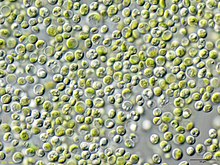
Spirulina is a biomass of cyanobacteria that can be consumed by humans and animals. The three species are Arthrospira platensis, A. fusiformis, and A. maxima.
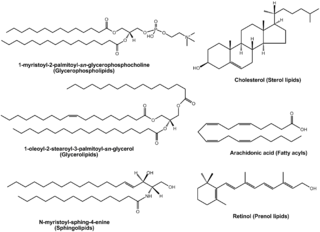
Lipidomics is the large-scale study of pathways and networks of cellular lipids in biological systems The word "lipidome" is used to describe the complete lipid profile within a cell, tissue, organism, or ecosystem and is a subset of the "metabolome" which also includes other major classes of biological molecules. Lipidomics is a relatively recent research field that has been driven by rapid advances in technologies such as mass spectrometry (MS), nuclear magnetic resonance (NMR) spectroscopy, fluorescence spectroscopy, dual polarisation interferometry and computational methods, coupled with the recognition of the role of lipids in many metabolic diseases such as obesity, atherosclerosis, stroke, hypertension and diabetes. This rapidly expanding field complements the huge progress made in genomics and proteomics, all of which constitute the family of systems biology.

Microalgae or microphytes are microscopic algae invisible to the naked eye. They are phytoplankton typically found in freshwater and marine systems, living in both the water column and sediment. They are unicellular species which exist individually, or in chains or groups. Depending on the species, their sizes can range from a few micrometers (μm) to a few hundred micrometers. Unlike higher plants, microalgae do not have roots, stems, or leaves. They are specially adapted to an environment dominated by viscous forces.
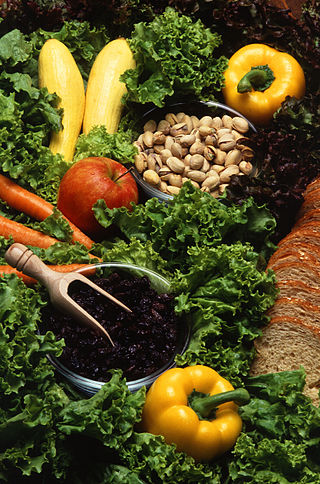
Vegetarian nutrition is the set of health-related challenges and advantages of vegetarian diets.
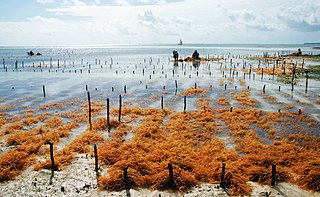
Algaculture is a form of aquaculture involving the farming of species of algae.

A photobioreactor (PBR) refers to any cultivation system designed for growing photoautotrophic organisms using artificial light sources or solar light to facilitate photosynthesis. Photobioreactors are typically used to cultivate microalgae, cyanobacteria, and some mosses. Photobioreactors can be open systems, such as raceway ponds, which rely upon natural sources of light and carbon dioxide. Closed photobioreactors are flexible systems that can be controlled to the physiological requirements of the cultured organism, resulting in optimal growth rates and purity levels. Photobioreactors are typically used for the cultivation of bioactive compounds for biofuels, pharmaceuticals, and other industrial uses.
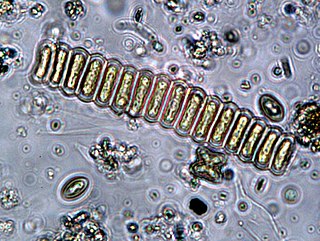
Scenedesmus is a genus of green algae, in the class Chlorophyceae. They are colonial and non-motile. They are one of the most common components of phytoplankton in freshwater habitats worldwide.
Auxenochlorella protothecoides, formerly known as Chlorella protothecoides, is a facultative heterotrophic green alga in the family Chlorellaceae. It is known for its potential application in biofuel production. It was first characterized as a distinct algal species in 1965, and has since been regarded as a separate genus from Chlorella due its need for thiamine for growth. Auxenochlorella species have been found in a wide variety of environments from acidic volcanic soil in Italy to the sap of poplar trees in the forests of Germany. Its use in industrial processes has been studied, as the high lipid content of the alga during heterotrophic growth is promising for biodiesel; its use in wastewater treatment has been investigated, as well.

Choricystis is a genus of green algae in the class Trebouxiophyceae, considered a characteristic picophytoplankton in freshwater ecosystems. Choricystis, especially the type species Choricystis minor, has been proposed as an effective source of fatty acids for biofuels. Choricystis algacultures have been shown to survive on wastewater. In particular, Choricystis has been proposed as a biological water treatment system for industrial waste produced by the processing of dairy goods.

Algae fuel, algal biofuel, or algal oil is an alternative to liquid fossil fuels that uses algae as its source of energy-rich oils. Also, algae fuels are an alternative to commonly known biofuel sources, such as corn and sugarcane. When made from seaweed (macroalgae) it can be known as seaweed fuel or seaweed oil.

Nannochloropsis is a genus of algae comprising six known species. The genus in the current taxonomic classification was first termed by Hibberd (1981). The species have mostly been known from the marine environment but also occur in fresh and brackish water. All of the species are small, nonmotile spheres which do not express any distinct morphological features that can be distinguished by either light or electron microscopy. The characterisation is mostly done by rbcL gene and 18S rRNA sequence analysis.
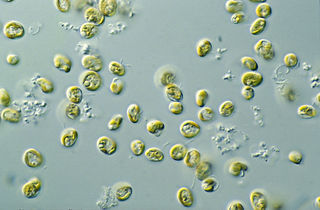
An algae bioreactor is used for cultivating micro or macroalgae. Algae may be cultivated for the purposes of biomass production (as in a seaweed cultivator), wastewater treatment, CO2 fixation, or aquarium/pond filtration in the form of an algae scrubber. Algae bioreactors vary widely in design, falling broadly into two categories: open reactors and enclosed reactors. Open reactors are exposed to the atmosphere while enclosed reactors, also commonly called photobioreactors, are isolated to varying extents from the atmosphere. Specifically, algae bioreactors can be used to produce fuels such as biodiesel and bioethanol, to generate animal feed, or to reduce pollutants such as NOx and CO2 in flue gases of power plants. Fundamentally, this kind of bioreactor is based on the photosynthetic reaction, which is performed by the chlorophyll-containing algae itself using dissolved carbon dioxide and sunlight. The carbon dioxide is dispersed into the reactor fluid to make it accessible to the algae. The bioreactor has to be made out of transparent material.

Spirodela polyrhiza is a species of duckweed known by the common names common duckmeat, greater duckweed, great duckmeat, common duckweed, and duckmeat. It can be found nearly worldwide in many types of freshwater habitat.
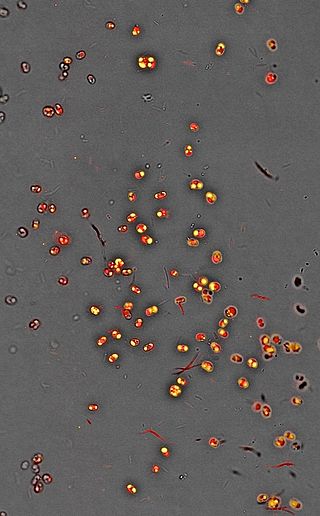
Nannochloropsis is a genus of alga within the heterokont line of eukaryotes, that is being investigated for biofuel production. One marine Nannochloropsis species has been shown to be suitable for algal biofuel production due to its ease of growth and high oil content, mainly unsaturated fatty acids and a significant percentage of palmitic acid. It also contains enough unsaturated fatty acid linolenic acid and polyunsaturated acid for a quality biodiesel.

Microalgae or microscopic algae grow in either marine or freshwater systems. They are primary producers in the oceans that convert water and carbon dioxide to biomass and oxygen in the presence of sunlight.
Crypthecodinium cohnii is a species of dinoflagellate microalgae. It is used industrially in the production of docosahexaenoic acid. Crypthecodinium cohnii is a heterotrophic non-photosynthetic Microalgae. C. cohnii can acclimate a higher docosahexaenoic acid to polyunsaturated fatty acids ratio, however current studies are trying to increase the volume of DHA production by creating mutant strains. Studies have shown that an increase in the supply of Dissolved Oxygen results in an increased production of DHA. In addition to oxygen concentration, C. cohnii is known to react to a change in salinity by changing their growth rate. C. cohnii's growth is highly dependent on their microbiome or environment. Most of the DHA in the Microalgae is found in the phospholipid, phosphatidylcholine. C. cohnii cultures require an organic carbon source to allow for accumulation of DHA. C. cohnii has been shown to accumulate other fatty acids and starch, especially due to nutrient limitation. C. cohnii showed the greatest accumulation of lipids when grown in a pH auxostat culture.
Schizochytrium is a genus of unicellular eukaryotes in the family Thraustochytriaceae, which are found in coastal marine habitats. They are assigned to the Stramenopiles (heterokonts), a group which also contains kelp and various microalgae.
Sammy Boussiba is a professor emeritus at the French Associates Institute for Agriculture and Biotechnology of Drylands at the Jacob Blaustein Institutes for Desert Research at Ben-Gurion University of the Negev, Israel.

Carbon capture and utilization (CCU) is the process of capturing carbon dioxide (CO2) from industrial processes and transporting it via pipelines to where one intends to use it in industrial processes.
